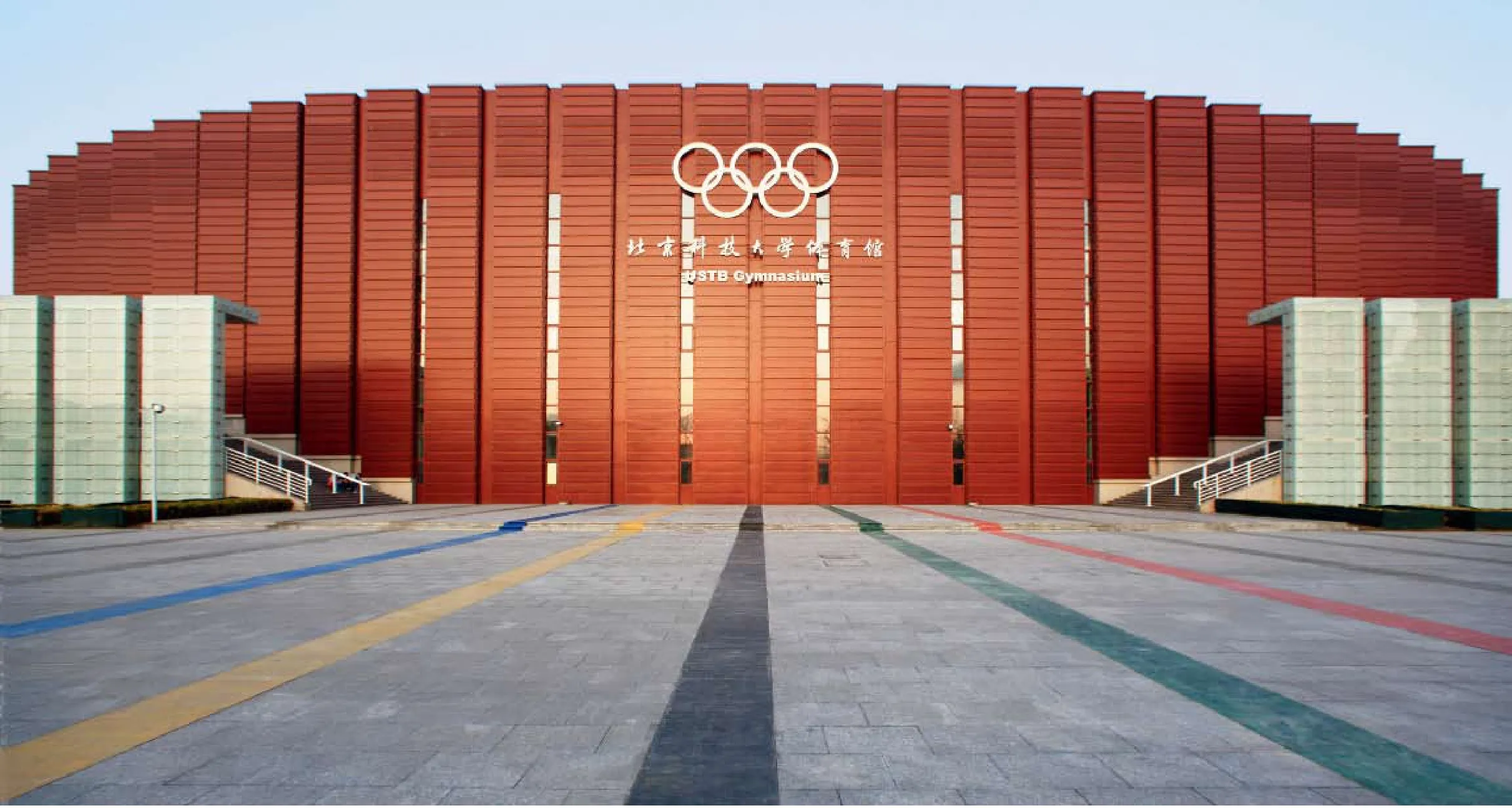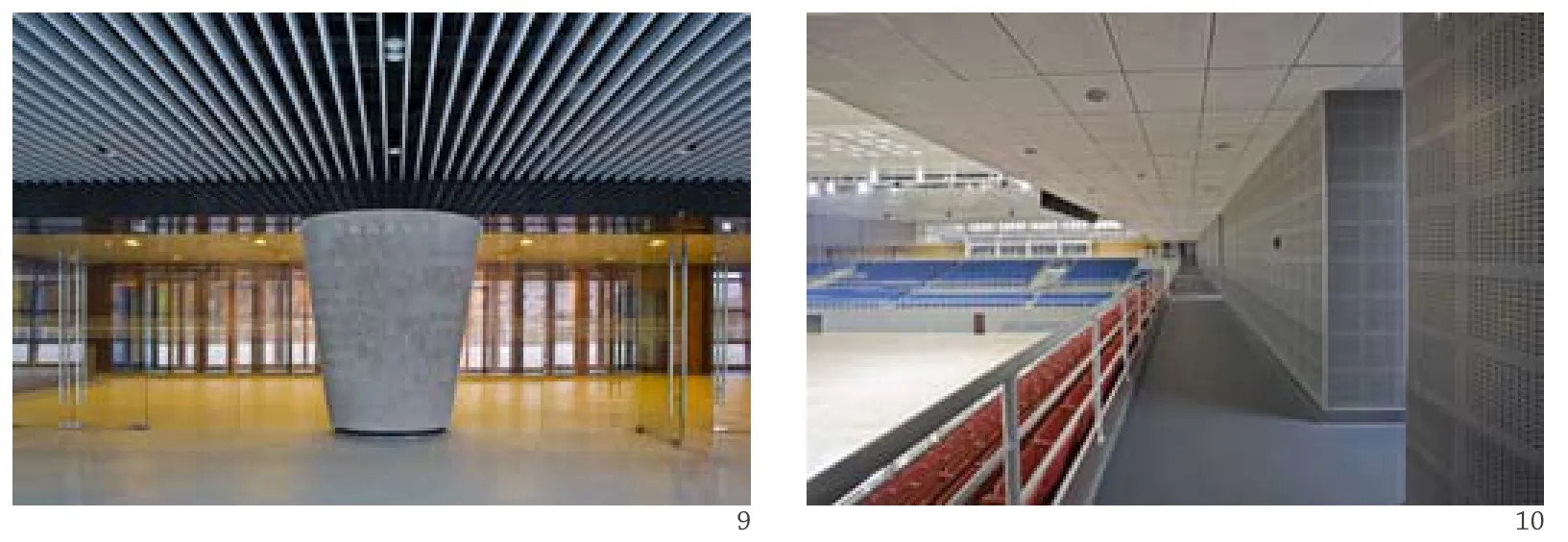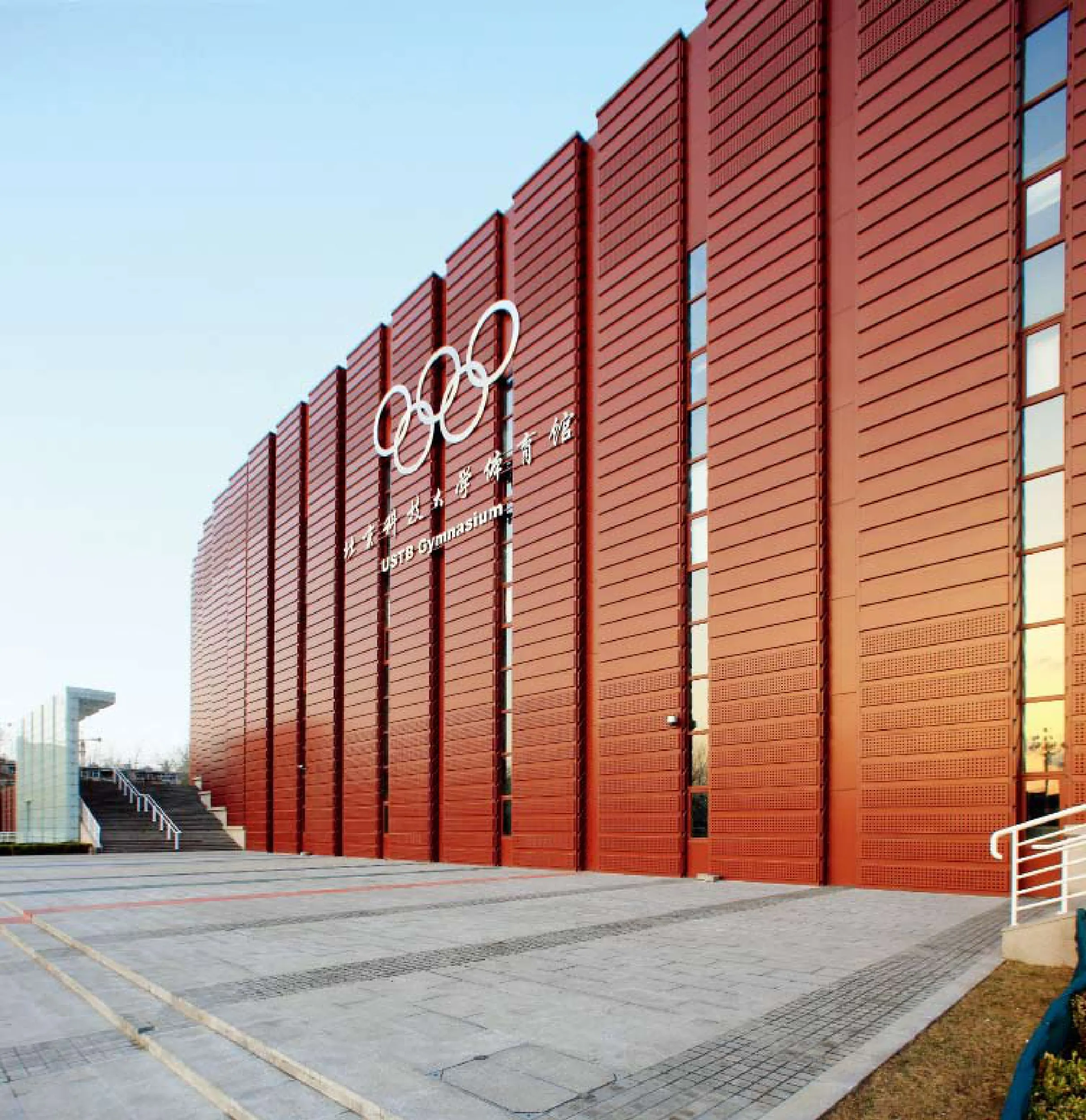2008北京奥运会柔道、跆拳道比赛馆(北京科技大学体育馆),北京,中国
2008北京奥运会柔道、跆拳道比赛馆(北京科技大学体育馆),北京,中国
Judo & Taekwondo Venue of 2008 Beijing Olympics Games (USTB Gymnasium), Beijing, China, 2007
2008奥运会北京柔道、跆拳道比赛馆(北京科技大学体育馆)作为北京2008年奥运会的主要比赛场馆之一,在奥运期间,承担奥运会柔道、跆拳道比赛,在残奥会期间作为轮椅篮球、轮椅橄榄球比赛场地。工程由主体育馆和一个50m×25m标准游泳池构成,总建筑面积24,662.32m2。该项目不仅是为奥运柔道跆拳道比赛所设计,而且将建设在大学校园里,如何应对奥运和校园的功能转换、特殊的地理人文环境、校园的场所特点、管理和运营的校园化特征是我们面对的挑战。因此,这是一个特殊的项目,建筑师在前期进行了充分的策划调研。
比赛区场地
主体育馆比赛区场地为60m×40m。该尺寸大小系奥运大纲中对柔道、跆拳道比赛要求的场地尺寸。这一尺寸也恰好满足赛后布置3块篮球场的基本要求,可以充分地满足赛后体育馆内的教学、训练和健身的需要。在一般高校的综合体育馆里这样大尺寸的场地是不多见的。其原因就是大场地会造成环绕场地坐席排布的分散,观众厅空间加大,而且会造成在小场地比赛项目时视距过远。满足奥运比赛要求和追求尽量大的内场以满足赛后多块篮球(甚至手球)场地的布置与赛后小场地比赛的观演形成了矛盾。解决这一矛盾的方法就是在内场设置活动看台。
固定看台、临时看台、活动看台
根据奥运大纲的要求,柔道、跆拳道馆的坐席数量必须达到8000座。但根据我们的设计理念,通过考察我国高校普通场馆的规模和使用特征,坐席数量一般设为5000席。因此,立足学校长远的使用要求,永久席位应以5000席为宜,另设3000席为临时坐席,赛后拆除。
由于本馆内场比赛区尺寸较大,如果5000个固定席围绕场地布置,3000个临时席又无法布置在比赛区内,赛后势必造成内场空旷、视距过远和空间浪费。所以,我们以学校实际使用情况出发,将3000个左右的临时席以脚手架搭建方式集中设在南北固定席之后的两块方整的平台上,赛后拆除座椅,可留下完整的两块场地。在比赛内场沿四边设置了1000个左右活动坐席,赛中及赛后教学训练时可以靠墙收入不影响内场的使用。
所以,最终设计观众坐席8012个,其中观众固定坐席4080个,租用3932席临时看台,满足奥运会柔道、跆拳道比赛及残奥会轮椅橄榄球、轮椅篮球比赛的要求。奥运会后,临时看台拆除,内场设有1230席活动看台,可以自由收放,总体可达5050标准席,可承担重大赛事(如残奥会盲人柔道、盲人门球比赛、世界柔道、跆拳道锦标赛),承办国内柔道、跆拳道赛事,举办学校室内体育比赛、教学、训练、健身、会议及文艺演出等活动,成为校内游泳教学、训练中心及水上运动、娱乐活动的场所。
赛中热身馆与赛后游泳馆
在项目立项开始,该馆就设计有50m×25m的游泳馆, 包含10条标准泳道。同样,我们立足学校长远使用,游泳馆的设计与主馆紧密结合,运动员区与淋浴更衣区紧凑布局,考虑师生的教学和对外开放,设有足够的更衣与淋浴空间。配合教学上课,设有宽敞的陆上训练和活动场地,并且在泳池边陆上场地设置了地板辐射采暖,为赛后学生和教师使用提供了人性化的设计。
赛中,游泳池被加上临时盖板,作为柔道、跆拳道热身场地。由于游泳馆与主馆的紧凑布局,使泳池改造的热身场地与比赛场距离很近,联系极为方便和顺畅,很好地贯彻了设计理念。
赛中功能定位与赛后功能转换
在设计中,我们以赛后长远使用为出发点,充分考虑赛后功能的转换。
考虑赛后体育馆所处的学校体育运动区能更大限度地为师生提供运动场地,总平面设计中尽量集中紧凑布局,力求在立面创新、符合场所精神的前提下,选取体形系数较小的单体造型,尽量节约用地,空出场地为赛后师生教学、锻炼健身使用。将体育馆南北两侧的健身绿化场地在赛时设为运动员、媒体及贵宾停车场,东侧沿主轴线设计成五环广场,赛后结合校园道路形成有纪念意义的永久性体育文化广场,五环广场南北侧的投掷场和篮球、网球场赛时作为BOB媒体专用场地。
馆内各空间赛时赛后功能转换如下:
新闻发布厅——舞蹈教室
分新闻中心——学生活动中心
贵宾餐厅——展览休憩
单项联合会办公——体育教研组
运动员休息检录——学生健身中心(赛时热身场地)
赛时热身及竞委会——标准游泳池
兴奋剂检查站——按摩理疗房
裁判员更衣室——健身中心更衣室
贵宾休息室——咖啡厅
临时观众席——篮球练习馆(或其他球类练习馆)
此外,在设计中贯彻的东西立面以实墙为主、南北主入口结合二层休息平台、方便拆卸的脚手架式的临时坐席系统、光导管自然采光系统、多功能集会演出系统、太阳能热水补水系统、游泳池地热采暖系统等设计策略的实施都实现了当初“立足学校长远使用,满足奥运会比赛要求”的设计理念。□

1.2 设计草图/Sketch

3 外景/Exterior view

4 鸟瞰/Bird's eye view
项目信息/Credits and Data
项目负责人/Principal in Charge: 庄惟敏/ZHUANG Weimin
设计团队/Design Team: 庄惟敏,栗铁,任晓东,梁增贤,董根泉等/ZHUANG Weimin, Ll Tie, REN Xiaodong, LIANG Zengxian, DONG Genquan, et al.
基底面积/Building Area: 23,800m2
总建筑面积/Total Floor Area: 24,662m2(地上/Aboveground, 22,060m2,地下/Underground, 2602m2)
檐口高度/Height of Eaves: 体育馆/Main Stadium, 23.75m;
游泳馆/Swimming Stadium, 13.14m
座席数/the Number of Seats:
赛时/ Olympic period: 8012个标准席(固定座席/Fixed seats, 4080个;临时座席/Temporary seats: 3932个)
赛后/Post-Olympic period: 5050个标准席(固定座席/ Fixed seats, 3820个;活动座席/Moveable seats, 1230个)
设计时间/Design Period: 2004.11-2005.9
竣工时间/Completion: 2007.11
摄影/Photos: 张广源/ZHANG Guangyuan
Serving as one of the primary competition venues of the 29th summer Olympic Games, the 2008 Beijing Olympics Judo & Taekwondo facility (USTB Gymnasium) successfully hosted judo and taekwondo games during the Olympics, as well as wheelchair basketball and wheelchair rugby games during the subsequent Paralympics. The building, consisting of a main arena and a Olympic-sized swimming pool (measured 50m long and 25m wide), has a gross floor area of 24,662.32 square meters. As it is located on a campus, it was designed not only for the games, but for future utilization by the university as well. As a result, the architect conducted investigations in order to ensure a functional transition between Olympic use and post-Olympic use, and to analyze the special geographic, social, and campus characteristics of the project’s genius-loci, management, and operation.
Competition zone courts
the dimensions of the competition area in the main arena were 60m x 40m, which was required by the IOC’s official guidelines for judo and taekwondo games. These requirements can also accommodate three basketball courts for post-Olympic usage by the university. Large competition areas such as this are not frequently found in many universities, as they often result in the dispersal of seating areas and expansion of audience hall, as well as excess of proper visual distance in the smaller-court games. The large-scale competition area, which was designed to be as large as possible as to fulfill Olympic requirements, obviously contradicts with multiple, comparably smaller-scale basketball (or handball) courts planned post-Olympics because of the visual distances involved. To solve this issue, moveable stands have been employed.
Permanent stands, temporary stands, and moveable stands
According to the IOC's guidelines, the number of seats in a judo & taekwondo arenas should be at least 8000. A capacity of 5000 was identified in the design concept, based on a precedent study of the scale and features of Chinese university arenas. therefore, based on future requirements of campus usage, 5000 permanent seats were planned to be installed. However, in order to meet IOC requirements, at least 3000 temporary seats needed to added for the Olympics.
If all of the 5000 permanent seats were to be placed fronting the competition zone, then the 3000 temporary seats typically would be located along the inner edges of the competition zone. this could have led to a void inner zone after the Olympics, with an excess of visual distance and waste of space due to the requirements of the competition areas. Therefore, the 3000 temporary seats were built on scaffolds on two platforms behind the northern and southern permanent seats, and will be removed to make room for two courts after the Olympics and Paralympic games. In addition, 1000 moveable seats were placed along four walls of the competition zone, which can be folded into the wall so as not to obstruct events during and after the Olympics.
As a result, the final designed number of seats was fixed at 8012, of which 4080 are permanent, 3932 were temporarily rented (fulfilling all requirements of judo and taekwondo games during the Olympics, as well as wheelchair basketball and wheelchair rugby games during the Paralympics), and 1230 are moveable. After the Olympics, the total number of permanent seats will be 5050, adequate for larger-scale sporting events, such as blind judo, goalball, international and domestic judo and taekwondo championships, campus sporting events, meetings, performances, as well asswimming and other types of recreation.

5 总平面/Site plan

6 首层平面/Floor 0 plan

7 外景/Exterior view
Warm-up gymnasium during Olympics & swimming pool after Olympics
The design also includes a standard ten-track swimming pool, measuring 50m long and 25m wide. the pool, located beside the main arena, takes future usage into consideration as well. the athlete areas and locker rooms have a compact layout, still providing sufficient locker space for teaching and public usage. For teaching purposes, there is a wide training court alongside the pool, as well as is an infloor radiant heating system surrounding the pool for the comfort of teachers and students.
During the Olympics, the swimming pool was capped with a temporary slab, which served as a warm-up zone for the judo and taekwondo events. It was especially convenient for the athletes to go back and forth between the warm-up zone and the adjacent competition zone, and this was a welcome and tangible result of the general design concept.
Function programming during Olympics and functional transition after Olympics
Post-Olympic reuse was highly considered in the design, based on the future usage and development of the building. In order to save land and create more space athletic spaces within the sports zone of the university campus, the building's plan has a compact layout. Based on the genius-loci of the site and innovations in the building's elevation, a simple volume with a small shape coefficient was selected, which makes the building space-efficient and energy-efficient. After the Olympics, parking lots for athletes, media staff and VIPs on the north and south side of the building have been turned into athletic areas, and the previous Olympic plaza on the east side, consistent with the campus axis and road network, has been transformed into a permanent cultural square that has a monumental significance. In addition, previous BOB media areas on the north and south side of the Olympic square have been converted into throwing sports, basketball and tennis courts.
The Olympic and post-Olympic use of interior spaces include:
Former news release hall—dancing classroom;
Former news sub-center—students activity center;
Former VIP dining room—exhibition space;
Former office for sport association—office for PE class teaching crew;
Former athletes' registration room—students' exercise center (warm-up zone);
Former warm-up zone and competition committee—standard swimming pool;
Former doping-check room—physical therapy room;
Former locker room for referee—locker room for Gymnasium;
Former VIP lounge—cafe;
Former temporary seats—basketball (or other ball sports) court.
In addition, some other details also vividly demonstrate the design concept of "fulfilling Olympic requirements and adapting to future longterm usage of the university", including east and west elevations which are primarily solid walls, public platforms on the second floor near the north and south entrances, the scaffold-like moveable temporary seating system, natural light conduit systems, multi-functional performance systems, a solar water-heating system, a floor radiation heating system around the swimming pool, etc.□
评论
郑方:1996年我从建筑学院毕业到设计院工作,不久就有幸跟随庄惟敏老师设计清华大学综合体育中心。当时并没有明确的设计任务书,但庄老师已经对大学体育场馆进行了清晰准确的定位。这一成功的定位已经在丰富多采的校园生活中得到时间的验证(后来我再师从庄老师修读博士学位,毕业典礼也恰好就在那个体育馆中举行)。这些理念在2004年北京科技大学体育馆的设计中再次被验证。庄老师以“是奥运的,更是校园的”定义这一场馆的性质,在功能计划、能源策略和技术选择上达到完美的统一。这个体育馆和同为2008年奥运会建设的北大体育馆、北工大体育馆一起,定义了我国大学体育场馆的综合性多功能校园场所的基本模式,亦为之后的大学场馆建设树立了典范,相信会在将来很长一段时间塑造校园公共生活的方式。
实际上,我国体育场馆的建设一向缺乏准确清晰的设计任务书,从功能使用到技术标准、运行策略都相当模糊。因此,建筑师需要同时担当建筑策划、设计甚至运行顾问的职责。北京科技大学体育馆不仅建立了适合校园生活的运动场地和游泳池,而且包含固定、临时和活动坐席的多样化看台,更以可持续策略为场馆引进创新的光导管自然照明,以降低校园建筑的运行成本,使其真正成为贴切适宜的设计。

8 入口局部/Entrance

9.10 内景/Interior views
Comments
ZHENG Fang:After graduating from School of Architecture in 1996, I began to work at the Institute of Architectural Design. Later on, I had the honor of designing the Sports Center of Tsinghua University with prof. ZHUANG Weimin. Despite the lack of a comprehensive design brief at that time, Mr. Zhuang had a clear concept for the sports center. the success of such definition in stimulating a colorful campus life has seen testified by time (I continued my doctoral study with prof. ZHUANG and my graduation ceremony happened to take place at that very sports center). The concepts adopted by prof. ZHUANG for the Sports Center of Tsinghua University were employed again in 2004 in the design of the University of Science and Technology Beijing (USTB) Gymnasium. In prof. ZHUANG's definition, the primary purpose of the Gymnasium is to serve the campus as well as the Olympic Games. He integrated functional planning, energy strategies and technological choices into his design. the USTB Gymnasium and two other gymnasiums built for the 2008 Summer Olympics, namely Peking University Gymnasium and Beijing University of Technology Gymnasium, became the basic model for multifunctional campus sports facilities in China. they also established a paradigm for later campus facility constructions and will help define campus community life in a long run.
In fact, the lack of clear design briefs has always been a problem in the construction of sports facilities in China. Programming, technical standards and operational strategies are all ambiguous. Therefore, architects undertaking such projects have to be adept at architectural programming, design and even operation consultation. USTB Gymnasium not only provides a playground and a swimming pool suitable for campus life, a multi-use grandstand equipped with permanent, temporary and mobile seats, but also introduces a sustainable strategy through an innovative tubular daylighting system which reduces the building's operating costs. All this has fulfilled the design purposes of the USTB Gymnasium.(English translation by Dandan WANG)

11 剖面/Section

12 观众入口/Audience entrance

